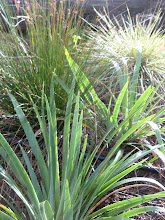Coastal Prairie
I tooks out some weeds, planted large groups of yellow eyed grass along the water course, planted some iris seed, took out a few plants that were in the wrong spot, and tried to think like garden designer, not just a restorationist.
I tooks out some weeds, planted large groups of yellow eyed grass along the water course, planted some iris seed, took out a few plants that were in the wrong spot, and tried to think like garden designer, not just a restorationist.
I took a clump of this chartreuse mystery sedge and divided it into five pieces to make a kind of carpet here by the patio. As you can see below, the chartreuse highlights the chartreuse of the calyx of the sticky monkeyflowers nearby. Subtle design, I know, but when you're limitting yourself to natives, and generally to the plants that appear naturally in your yard (the free ones), you take what you get. I'll know the cleverness of the design, if no one else notices. Besides, it's a fun experiment. I may want to add some native bulbs like Triteleia laxa among the sedges, if the area needs some punch.

I cut back lots of the perrenials, including two Penstemon heterophyllous. Just for fun, I cut the material into segments and stuck them in the soil of the prairie here and there, to see if any will be rooted by next spring. Most of the cuttings had two nodes, one leafless and stuck in the ground, the other one left with leaves, unlike the cutting photographed below. I also stuck some in pots. Did the same thing with some mugwort.

Herbs and Water Way
Pictured below, is the path along the south side of the house, which is at the bottom of a solid clay slope (plants are having a real tough time growing there). On the left side we have part of the herb garden and on the right we have the water way that connects to the water course of the coastal prairie. (If you were to walk down the path, you'd see the bog right around the bend.) The herbs are in heavily amended soil (for drainage) and get good light. I cut the lavender back HARD, hand-mowed the thyme carpet, and cleaned up any dead material. On the water way, I removed a bunch of yellow eyed grass, consolidated plants into patches, and hand-mowed the springbank clover carpet, to encourage it to grow lower and thicker, and used the cut pieces to extend the carpet. Eventually I want it to cover the mud you see between the stones and path.

A closer look reveals why I chose springbank clover for this area. Besides being a native and having attractive flowers, I knew this plant could handle the seasonal flooding. I see it growing right along the shores of Big Lagoon.

It also spreads nicely, is edible, has historical significance (was a major food source for local native peoples), and is bright green. And who else gardens with clover?
On the rocks above the clover carpet, all kinds of plants are growing, including a Lilium pardilinum, planted a couple years ago. This week I was bold, and pulled that plant up. The bulbs are amazing.

I divided the bulb into three clumps and rubbed off some of the bulb scales to plant throughout the rocks, especially near the bog. And planted pieces of Mimulus lewisii as companions. My hope is to get more Boykinia elata in there too (right now I only have one).
Forest
As for the forest, I've just been admiring it. The hazel is turning yellow, more mushrooms are popping up, and the big leaf maple has lost its leaves.


No comments:
Post a Comment